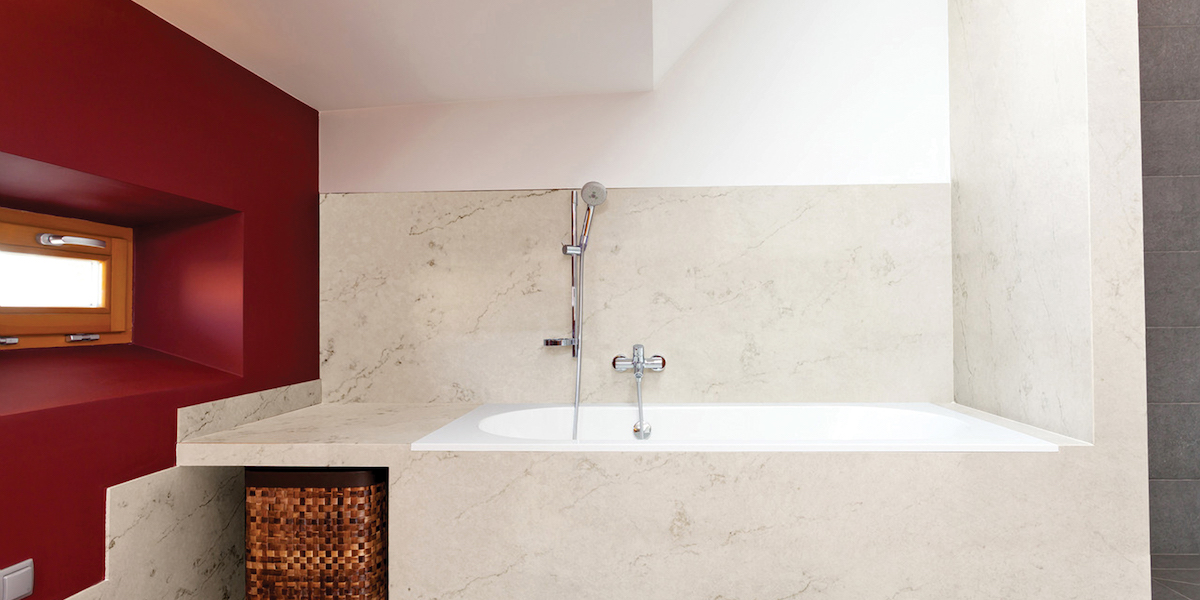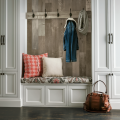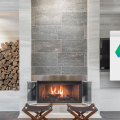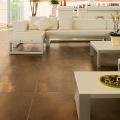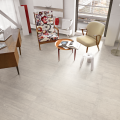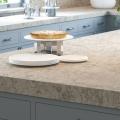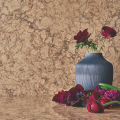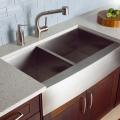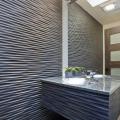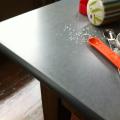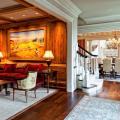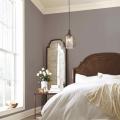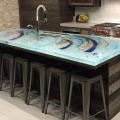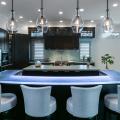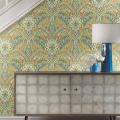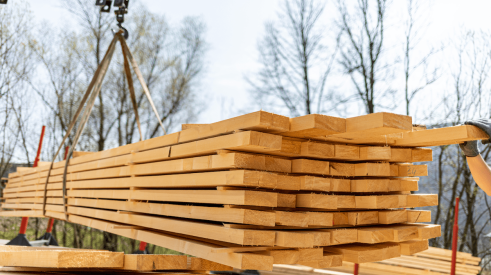Every movement spawns a countermovement. The incorporation of technologies into everyday life that make services and information available 24/7 is being offset by consumers’ desire for homes that ensure comfort and well-being and that bring the calm and serenity of nature from outdoors inside. Perhaps the most all-encompassing trend in surfacing materials today is the popularity of nature-inspired patterns and colors, whether the surface is man-made or from the earth.
Wall Treatments and Coverings
Because it can be quickly added and changed, paint is a great way to bring on-trend colors into whole rooms or accent walls. Sherwin-Williams has chosen earthy Poised Taupe as its 2017 Color of the Year. “Poised Taupe celebrates everything people love about cool gray as a neutral, and also brings in the warmth of brown, taking a color to an entirely new level,” says Sue Wadden, director of color marketing for the paint manufacturer. “Not cool or warm, not gray or brown, Poised Taupe is a weathered, woodsy neutral bringing a sense of coziness and harmony that people are seeking.”
Wall coverings are another affordable way to bring character and color to a space. According to Carol Miller, marketing manager for York Wallcoverings, in York, Pa., “Wall coverings are definitely more popular now than five years ago. Wallpaper as a status symbol never went out of style for interior designers, and as the economy improves, the luxury of wallpaper is reemerging. The beauty and warmth it brings to any interior, along with consumers’ desire for personalized space, make it a perfect fit.” York has selected Lunar Gray as its 2017 Color of the Year because the company feels it works well with the on-trend colors and patterns that are dominant in home furnishings and accessories. “Lunar gray is a light, warm, sophisticated hue that is elegant but playful and feels both organic and man-made, like stone and concrete; so versatile, chameleon-like,” Miller says.
Wall coverings can create visual delineation within a space and enliven small, minimally furnished areas such as entryways and hallways. “Murals as an impact statement are also a big trend,” Miller says. “Their scenic nature brings the feeling of the outdoors in, and they visually expand space. If the mural is abstract, it satisfies the demand for wall art, which is surging in the marketplace.”
And wall treatments can be more than just pleasing to the eye. The healthy home trend is addressed by Sherwin-Williams’ microbicidal product, Paint Shield. The paint, which is registered with the Environmental Protection Agency, kills more than 99.9 percent of five types of harmful bacteria, including staph, MRSA (methicillin-resistant Staphylococcus aureus), and E. coli within two hours of exposure on a painted surface. The paint will continue to kill 90 percent of bacteria after repeated contamination for up to four years. It’s offered in the company’s popular eggshell finish and can be applied on interior hard, nonporous ceilings, walls, doors, and trim.
Sometimes it’s using a traditional material in a new way that makes for innovation. Sara Babinski, design manager, hardwood and laminate at Armstrong Flooring, in Lancaster, Pa., sees designers using flooring laminates on walls as accents and to create dramatic design effects.
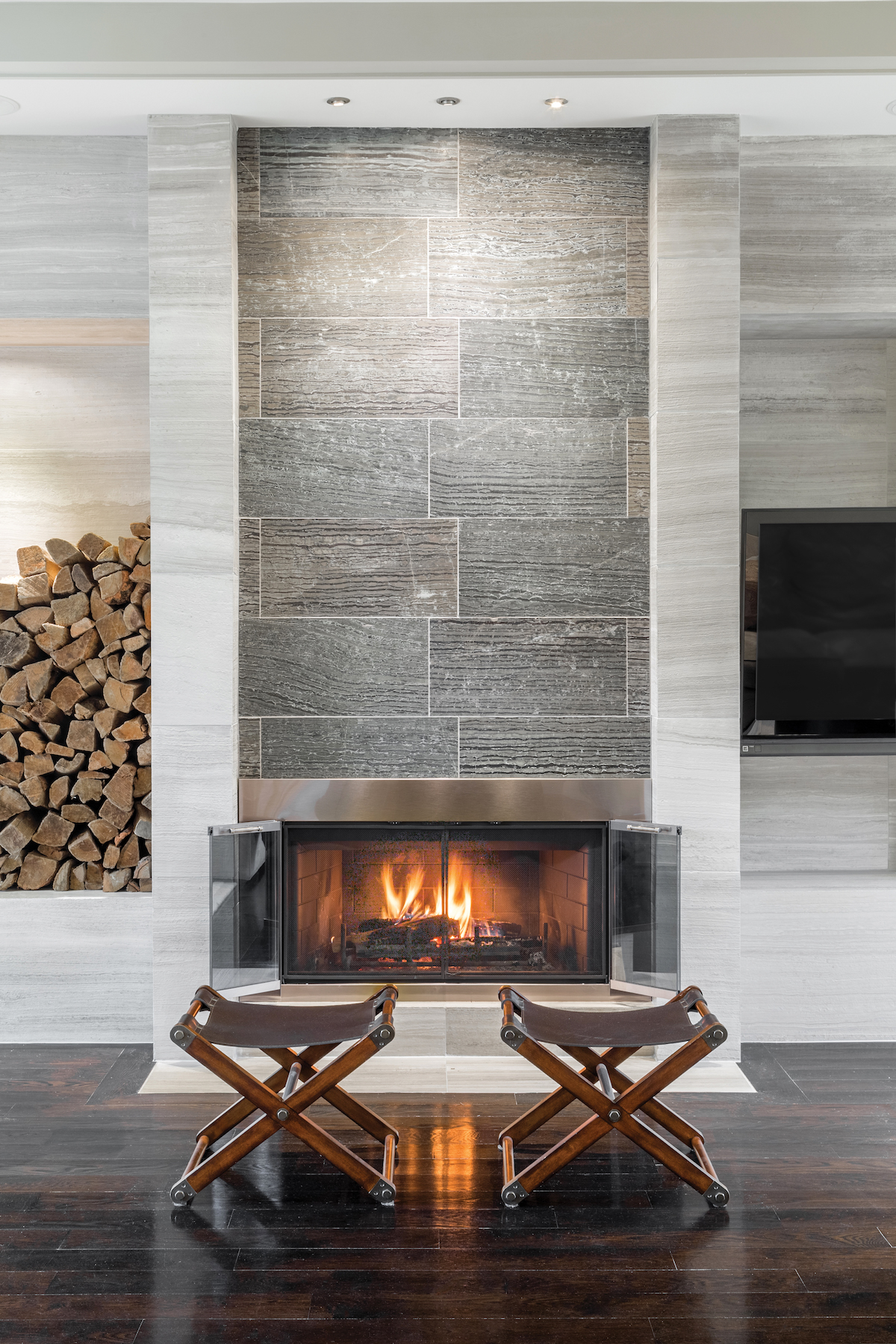 This hearth, clad in Artistic Tile’s Zebrano stone tile, reflects increased homebuyer interest in natural-looking surfaces. (Click to enlarge)
This hearth, clad in Artistic Tile’s Zebrano stone tile, reflects increased homebuyer interest in natural-looking surfaces. (Click to enlarge)
Countertop Materials and Trends
“There continue to be more and more countertop materials available,” says Larry W. Garnett, head of Professional Builder’s House Review team and owner of Larry Garnett Designs, in Glen Rose, Texas. “Granite, which was once the hands-down first choice, now has competition. I’m seeing more interest in engineered quartz and soapstone.”
Alyssa Smith, assistant designer at Phil Kean Design Group, in Winter Park, Fla., says, “We’ve seen a rise in man-made materials and finishes that successfully mimic natural stone.” And the available patterns in engineered quartz have moved further into looks that echo granite, marble, and other types of stone. Unlike granite, engineered quartz is more versatile: It can be crafted into unique shapes, and the color and pattern remain consistent from one slab to the next. It’s also nonporous, stronger than granite, and is stain, scratch, crack, and chip resistant. Engineered quartz doesn’t require sealants or waxes like granite does.
Although a marble-white look is perennially popular in engineered quartz, Erika Egede-Nissen, director of brand marketing at Caesarstone US, explains, “Gray is one of the best colors to use as a neutral palette. Because we’re seeing a lean toward color integration in the home, gray allows you to mix in pops of color without overwhelming the space.” Egede-Nissen adds, “We also love the integration of multiple colors or surface types,” and reports seeing wood mixed with a surface stone, as well as the use of solid color, such as cast concrete, for the perimeter of the kitchen and white and gray for a family-size island. “As room design returns to a more layered look, sculpted edge profiles are going to take priority over giant, thick edges,” she says.
Katie Congress, residential marketing manager at DuPont Protection Solutions, says that U.S. trends in the thickness of surfacing materials tend to be influenced by what’s popular in Europe. Both very thin (½ inch) and very thick (6 inches) slabs are popular, she says, noting that some designers opt for a thicker kitchen island surface and a thinner perimeter counter.
Homeowners’ desire for personalization and something different has led to interest in a range of innovative materials and fabrication processes for countertops. Glass is a nonporous, easy to clean, hygienic, and virtually maintenance-free surface. It doesn’t stain and can endure high heat without scorching or cracking.
ThinkGlass, headquartered in Boisbriand, Quebec, Canada, specializes in custom glass applications. Homeowners looking for a special island countertop or vanity top can choose from a variety of colors, thicknesses, edge treatments, and sizes, and can even integrate artwork into the countertop. “The other interesting aspect of glass design is that it may be edge lit to transform an application, giving it a floating or ethereal feel,” says Mélanie Lachance, marketing coordinator at ThinkGlass.
For homeowners interested in an earth-friendly option that’s made in the U.S., consider IceStone composite made with recycled glass. “The most popular colors used in both kitchens and baths are the whites: White Pearl, Snow Flurry, and Alpine White,” says Derek Hawkins, former marketing manager at IceStone, in Brooklyn, N.Y. When comparing the aesthetic of IceStone to engineered quartz, Hawkins explains, “It has a different look. The White Pearl option, for example, has a shine and radiance that’s different from similar colors in engineered quartz.” IceStone countertops are priced about the same as higher-end granites and marbles. Like granite, IceStone is porous and needs to be sealed every few years.
Another unique alternative is PaperStone surfacing, a material made from 100 percent postconsumer recycled paper in combination with a proprietary petroleum-free resin. The material is stain resistant, nonporous, and can be used in both vertical and horizontal applications, including countertops, wall cladding, cabinetry, and furniture. It’s eco-friendly, made in Washington state, and distributed through IceStone. Hawkins explains that PaperStone surfacing is mid-tier in price, is durable, and feels like wood. It can be milled into myriad shapes and treated with a variety of finishes.
 From left: Innovations in surfacing include nonporous PaperStone cladding made from recycled paper and resin; edge-lit glass by ThinkGlass that offers drama and depth; and concrete tiles by Tesselle, with slight variations that impart a handmade feel. (Click to enlarge)
From left: Innovations in surfacing include nonporous PaperStone cladding made from recycled paper and resin; edge-lit glass by ThinkGlass that offers drama and depth; and concrete tiles by Tesselle, with slight variations that impart a handmade feel. (Click to enlarge)
Versatile, Ever-Popular Tile
Lauren Cherkas, retail president of Artistic Tile, in Secaucus, N.J., notes an “explosion” of large tile used throughout the home, regardless of materials. Jacklyn Graniczny, partner/designer at Sublime Homes, in St. John, Ind., agrees. “Large-format tile is all the rage, defined as 12 by 24 inches up to 40 by 120 inches, and in some cases, even larger,” Graniczny says. “It’s great for high-traffic areas such as kitchens and baths. And we’re seeing the larger pieces installed on shower walls and used as countertops, which is a big trend at KBIS this year.” Tile can be used on walls, countertops, and floors; large-scale, it offers a clean look with fewer grout lines and less visual interruption.
In the kitchen and bath, Cherkas says anything goes: “White and gray continue to lead the charge in natural stone, ceramic, glass, and porcelain tile, but customers are also inclined to add color and texture to designs.” Tile is a good flooring choice for those with allergy and indoor air quality concerns.
The wide variety of available materials and designs includes porcelain, natural stone, concrete, and glass. Concrete tile is most often used on floors and walls in kitchens and baths, but Karin Jeske, co-owner and designer at Tesselle, in Riverside, Calif., notes that her customers spec concrete tile for countertops and backsplashes, floors and walls, and around the perimeter of fountains. Durable and easy to maintain, concrete tile can project a handmade feel, due to slight variations.
Glass tiles are available in a variety of shapes, sizes, finish options, and colors. The tiles can be back-painted with a color or pattern, through-body colored, or hand-scooped, poured, and mixed to create artistic striations. “Patterned mosaic glass tile continues to be our most frequently purchased product in a variety of colors and blends,” says Jennifer Dossett, content marketing specialist at Oceanside Glasstile, in Carlsbad, Calif. Used most often on kitchen backsplashes, in bathrooms, and on fireplaces and feature walls, the look and feel of glass is a distinguishing factor. “Glass tile has more dimensionality and shine than other types of tile,” Dossett says.
Feature walls are a popular trend that can serve as a memory point and sales tool. They reflect the consumer demand for self-expression and personalization, and they underscore the fact that, while the choice of material involves a combination of considerations, there’s increased attention being paid to the idea of the surface as art.
Wanda Jankowski, a writer based in New York, covers products and architectural design. She has written several books on design.
Advertisement
Related Stories
Design
What Gen-Z Buyers Really Want in a Home
The fervor of planning for Millennials in the home building industry has now pivoted to Gen Z. So, what does this new generation want?
Building Materials
Lumber Leads Building Materials Prices Higher in March
Overall, the cost of building materials rose during March, with softwood lumber, gypsum products, and concrete all seeing price increases. Only steel mill materials saw price drops
Demographics
Post-Pandemic Trends: Working From Home
A greater share of workers are still working from home than before the pandemic and they're concentrated in the information, professional, and financial services sectors


